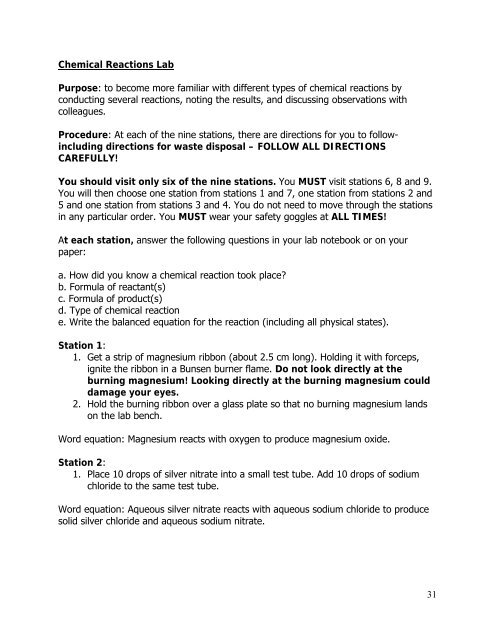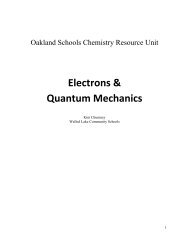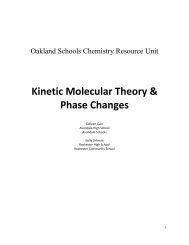Nomenclature and Chemical Reactions - Oakland Schools
Nomenclature and Chemical Reactions - Oakland Schools
Nomenclature and Chemical Reactions - Oakland Schools
You also want an ePaper? Increase the reach of your titles
YUMPU automatically turns print PDFs into web optimized ePapers that Google loves.
<strong>Chemical</strong> <strong>Reactions</strong> Lab<br />
Purpose: to become more familiar with different types of chemical reactions by<br />
conducting several reactions, noting the results, <strong>and</strong> discussing observations with<br />
colleagues.<br />
Procedure: At each of the nine stations, there are directions for you to followincluding<br />
directions for waste disposal – FOLLOW ALL DIRECTIONS<br />
CAREFULLY!<br />
You should visit only six of the nine stations. You MUST visit stations 6, 8 <strong>and</strong> 9.<br />
You will then choose one station from stations 1 <strong>and</strong> 7, one station from stations 2 <strong>and</strong><br />
5 <strong>and</strong> one station from stations 3 <strong>and</strong> 4. You do not need to move through the stations<br />
in any particular order. You MUST wear your safety goggles at ALL TIMES!<br />
At each station, answer the following questions in your lab notebook or on your<br />
paper:<br />
a. How did you know a chemical reaction took place?<br />
b. Formula of reactant(s)<br />
c. Formula of product(s)<br />
d. Type of chemical reaction<br />
e. Write the balanced equation for the reaction (including all physical states).<br />
Station 1:<br />
1. Get a strip of magnesium ribbon (about 2.5 cm long). Holding it with forceps,<br />
ignite the ribbon in a Bunsen burner flame. Do not look directly at the<br />
burning magnesium! Looking directly at the burning magnesium could<br />
damage your eyes.<br />
2. Hold the burning ribbon over a glass plate so that no burning magnesium l<strong>and</strong>s<br />
on the lab bench.<br />
Word equation: Magnesium reacts with oxygen to produce magnesium oxide.<br />
Station 2:<br />
1. Place 10 drops of silver nitrate into a small test tube. Add 10 drops of sodium<br />
chloride to the same test tube.<br />
Word equation: Aqueous silver nitrate reacts with aqueous sodium chloride to produce<br />
solid silver chloride <strong>and</strong> aqueous sodium nitrate.<br />
31
















